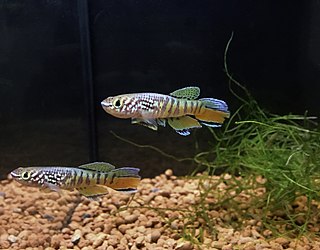
Mackerel is a common name applied to a number of different species of pelagic fish, mostly from the family Scombridae. They are found in both temperate and tropical seas, mostly living along the coast or offshore in the oceanic environment.

Herring are forage fish, mostly belonging to the family of Clupeidae.

"Sardine" and "pilchard" are common names for various species of small, oily forage fish in the herring family Clupeidae. The term "sardine" was first used in English during the early 15th century; a folk etymology says it comes from the Italian island of Sardinia, around which sardines were once supposedly abundant.

Pelvicachromis pulcher is a freshwater fish of the cichlid family, endemic to Nigeria and Cameroon. It is popular amongst aquarium hobbyists, and is most commonly sold under the name kribensis, although it has other common names, including various derivatives and color morphs of the kribensis: krib, common krib, red krib, super-red krib and rainbow krib, along with rainbow cichlid and purple cichlid.

The pennant coralfish, also known as the longfin bannerfish, reef bannerfish or coachman, is a species of fish of the family Chaetodontidae, native to the Indo-Pacific area.
The tenspine grouper is a species of marine ray-finned fish, a grouper from the subfamily Epinephelinae which is part of the family Serranidae, which also includes the anthias and sea basses. It is found along the western coast of Mexico and Central America, but is a very rare fish of which little information exists.

The blue lyretail, also known as the Gardner's killi and formerly as the steel-blue aphyosemion. It is a species of killifish endemic to freshwater habitats in Nigeria and Cameroon.

Eels are ray-finned fish belonging to the order Anguilliformes, which consists of eight suborders, 19 families, 111 genera, and about 800 species. Eels undergo considerable development from the early larval stage to the eventual adult stage and are usually predators.

An anchovy is a small, common forage fish of the family Engraulidae. Most species are found in marine waters, but several will enter brackish water, and some in South America are restricted to fresh water.

Lake Barombi Koto, also known as Lake Barombi Kotto or Lake Barombi-ba-Kotto, is a small lake in the volcanic chain in the Southwest Region of Cameroon. It is a volcanic lake with a diameter of about 1.2 km (0.75 mi). There is a small island in the middle, which is densely inhabited by the Barombi, a tribe of fishers. The Tung Nsuia and Tung Nsuria streams, each about 1–2 m wide and 0.3 m deep near their mouth, are the only inflows into the lake, and they dry out in dry season.

Fundulopanchax is a genus of killifish living in near-coastal fresh water streams and lakes in Western Africa. All species were previously biologically classified as members of the genus Aphyosemion, with the exception of Fundulopanchax avichang, F. gresensi and F. kamdemi, which were all scientifically described after the major revision of the Aphyosemion complex.

Aphyosemion is a genus of African rivulines endemic as the name indicates to Africa. Many of these species are popular aquarium fish.

The emerald aphyosemion is a species of killifish, endemic to the lower Cross River basin in Nigeria. It is a coastal rainforest fish which lives in small streams and ponds. It prefers a temperature of around 75 °F (24 °C), and a slightly acidic pH around 6–7. The specific name honours the Danish count, army colonel, explorer and ichthyologist Jørgen J. Scheel (1916–1989).

Aphyosemion bivittatum is a species of freshwater fish belonging to the family Aplocheilidae. It is found in rivers in southeastern Nigeria and southwestern Cameroon. It was originally described as Fundulus bivittatus by Swedish zoologist Einar Lönnberg in 1895. The holotype was discovered near a waterfall in the Ndian River in Cameroon and currently is located in the Stockholm Museum.

Aphyosemion australe, the lyretail panchax, golden panchax or Cape Lopez lyretail, is a species of freshwater fish belonging to the family Aplocheilidae. It is found around Cape Lopez and in surrounding areas in Gabon.
Aphyosemion elegans, the elegant killifish, is a species of African rivulines (Nothobranchiidae) endemic to Africa, where it is found in the basin of the Congo River.

Fundulopanchax sjostedti, the blue gularis, golden pheasant gularis or red aphyosemion, is a species of toothcarp endemic to the Niger delta. It is only found in Nigeria and Cameroon. It is named after the Swedish naturalist Bror Yngve Sjöstedt (1866–1948) who collected the type specimen close to a waterfall by the Ndian River, in the Ndian department in Cameroon's Southwest Region.

















